Are you a pizza lover who also wants to maintain a healthy weight? Tracking the calories in small pepperoni pizzas can help you stay on track with your dietary goals. Understanding the calorie content of these delicious pizzas is essential for anyone who wants to strike a balance between indulgence and health. By being mindful of portion sizes and making informed choices, you can enjoy your favorite pizza while still maintaining a balanced and nutritious diet.
When it comes to small pepperoni pizzas, the calorie count can vary depending on factors such as slice size and crust type. Toppings like pepperoni and cheese tend to add more calories, while vegetables can offer valuable nutrients. It’s important to be aware of these calorie variations so that you can make choices that align with your health goals.
One option to consider is homemade pizzas. Homemade pizzas generally have fewer additives and can be a healthier alternative to store-bought ones. By making your own pizza, you have control over the ingredients and can customize it to suit your dietary needs.
Portion control is another crucial aspect to bear in mind. While small pepperoni pizzas may seem innocent, consuming multiple slices can quickly add up in terms of calorie intake. Being mindful of portion sizes and opting for smaller servings can help you strike the right balance between indulgence and calorie management.
If you’re looking for resources to help you track small pepperoni pizza calories, there are various apps and websites available that provide accurate information. These tools can assist you in staying on top of your dietary goals and make informed choices when it comes to enjoying your favorite pizza.
In conclusion, tracking the calories in small pepperoni pizzas is essential for anyone who wants to maintain a balanced diet. By understanding the calorie content, practicing portion control, and making informed choices, you can enjoy your pizza while still staying on track with your health goals.
Key Takeaways
- Tracking small pepperoni pizza calories can help you maintain a healthy weight and make informed choices.
- The calorie content of small pepperoni pizzas can vary based on slice size and crust type.
- Toppings like pepperoni and cheese add more calories, while vegetables offer valuable nutrients.
- Consider making homemade pizzas for a healthier alternative with fewer additives.
- Portion control is key, as multiple slices can quickly increase your calorie intake.
Understanding the calorie content of small pepperoni pizzas is crucial for anyone aiming to maintain a balanced diet. It’s important to be aware of the number of calories in each slice and how it can impact your overall calorie intake. Keeping track of your calorie intake can help you make informed choices about what and how much you eat.
Calories in small pepperoni pizzas can vary depending on factors such as the size of the slice and the type of crust. Thin crusts tend to have fewer calories compared to thicker crusts. Toppings like pepperoni and cheese can significantly increase the calorie count, while incorporating vegetables can provide valuable nutrients without adding excessive calories. By monitoring your calorie intake, you can make adjustments to your diet and ensure you are consuming a balanced amount.
Maintaining portion control is another essential aspect of monitoring calorie intake. It’s easy to overindulge in pizza, especially when it’s delicious small pepperoni pizza. By being mindful of portion sizes and moderating how much you eat, you can enjoy your favorite pizza while still managing your calorie intake. It’s also helpful to consider healthier alternatives, such as adding more vegetables or opting for a lighter crust option, to reduce calories without sacrificing taste.
| Crust Type | Calories per Slice |
|---|---|
| Thin Crust | 150-200 |
| Regular Crust | 200-250 |
| Deep Dish Crust | 250-300 |
Fortunately, there are various resources available to help you track your calorie intake effectively. Apps and websites dedicated to nutrition tracking can provide accurate information about the calorie content of small pepperoni pizzas and help you stay on top of your dietary goals. By utilizing these tools, you can make more informed choices and manage your calorie intake more efficiently.
Remember, moderation and balance are key when it comes to enjoying small pepperoni pizzas as part of a healthy diet. While it’s essential to track your calorie intake, it’s also important to indulge in moderation and maintain a balanced approach to eating. By being mindful of your choices and monitoring your calorie intake, you can enjoy small pepperoni pizzas while still working towards your health goals.
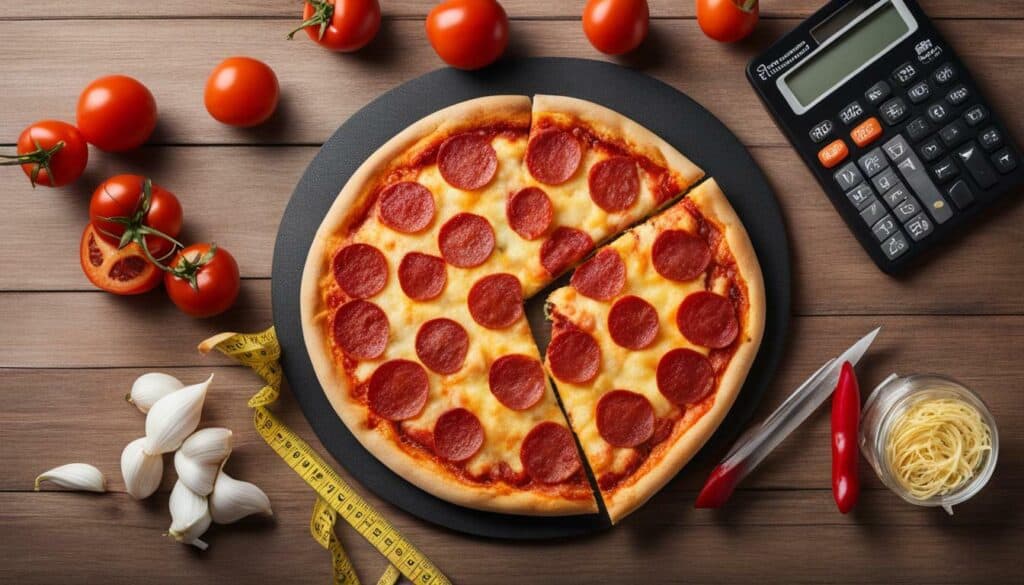
When enjoying small pepperoni pizzas, consider incorporating nutritious toppings to boost the nutritional value of your meal. Adding vegetables like bell peppers, onions, or mushrooms not only adds flavor but also provides essential vitamins and minerals. Additionally, consider opting for lean protein options such as grilled chicken or turkey as a substitute for traditional pepperoni. These simple substitutions can help you create a more balanced and nutritious pizza without compromising on taste.
Factors Affecting Calorie Content
The calorie count of a small pepperoni pizza can vary depending on factors such as toppings, crust type, and whether it’s homemade or store-bought. Toppings like pepperoni and cheese add more calories, while vegetables can provide valuable nutrients. Homemade pizzas generally have fewer additives and can be healthier options for those conscious of their calorie intake.
Let’s take a closer look at the calorie content of various small pepperoni pizza components. On average, a small slice of pepperoni pizza from a popular pizza chain can range from 200 to 300 calories, with some variations based on the thickness of the crust and the amount of cheese used.
| Topping | Calories per Slice (Small Pizza) |
|---|---|
| Pepperoni | Approximately 60-80 calories |
| Cheese | Approximately 40-60 calories |
| Vegetables (e.g., onions, bell peppers) | Approximately 5-20 calories |
It’s important to be mindful of portion sizes when enjoying small pepperoni pizzas. Eating just one or two slices and complementing them with a side salad or a serving of vegetables can help balance the meal and keep the overall calorie count in check.
If you’re aiming to reduce calorie intake, there are healthier alternatives you can consider. Opting for a thin crust instead of a thicker one can help save some calories. You can also experiment with whole wheat or cauliflower crusts for added nutritional value. Additionally, using turkey pepperoni or reducing the amount of cheese can further cut down on calorie content while still enjoying the flavors of a small pepperoni pizza.
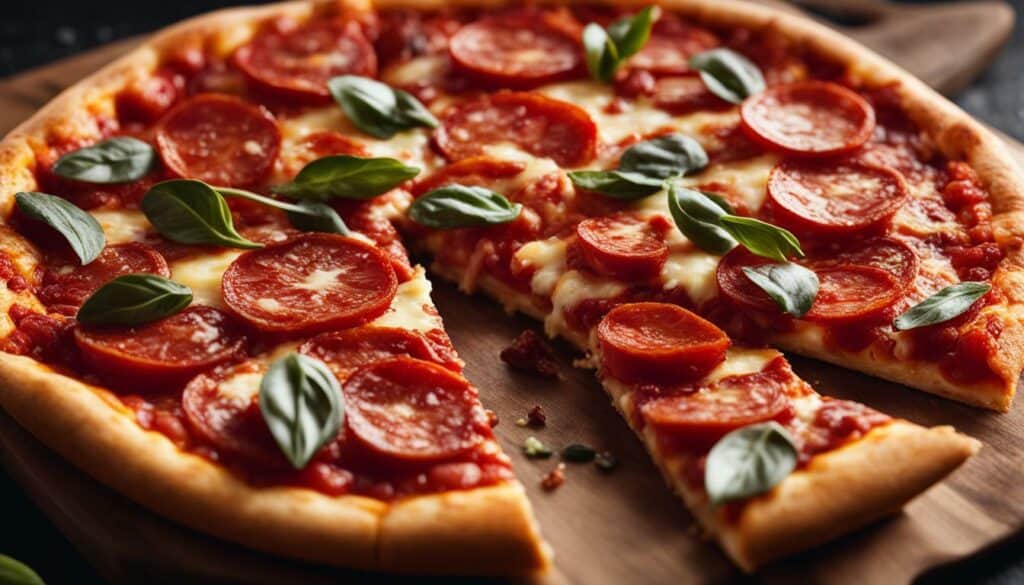
“Understanding the calorie content of small pepperoni pizzas is essential for anyone trying to track their intake for a balanced diet. By considering factors like toppings, crust type, and portion sizes, individuals can make informed choices that align with their health goals.”
In summary, small pepperoni pizza calories can vary based on toppings, crust type, and whether it’s store-bought or homemade. Being aware of these factors and opting for healthier options or practicing portion control can help maintain a balanced diet. Remember, moderation and balance are key when including small pepperoni pizzas as part of a healthy eating plan.
Portion Control and Calorie Reduction
Practicing portion control is key when it comes to consuming small pepperoni pizzas as part of a balanced diet. Understanding the appropriate portion sizes can help individuals maintain a calorie-conscious approach while still enjoying this delicious dish. It’s important to note that the calorie count of a small pepperoni pizza can vary depending on factors such as slice size and crust type. By being mindful of portion sizes, individuals can better manage their calorie intake and ensure they stay on track with their dietary goals.
One helpful tip for portion control is to divide the pizza into smaller servings. This not only helps in managing calorie intake but also gives a sense of satisfaction as you savor each slice. It’s important to remember that even small changes in portion sizes can make a big difference over time. By reducing the number of slices or opting for a smaller slice, you can effectively decrease your calorie consumption without depriving yourself of the flavors you love.
When it comes to reducing calorie intake, it’s also crucial to consider healthier alternatives. Adding more vegetables as toppings can not only enhance the nutritional value of your pizza but also help reduce calorie content. Vegetables like bell peppers, onions, and mushrooms can provide valuable nutrients while adding a delightful crunch and flavor. Additionally, choosing a thinner crust or opting for whole wheat crust can be a healthier choice as it generally contains fewer calories compared to thicker or white crusts.
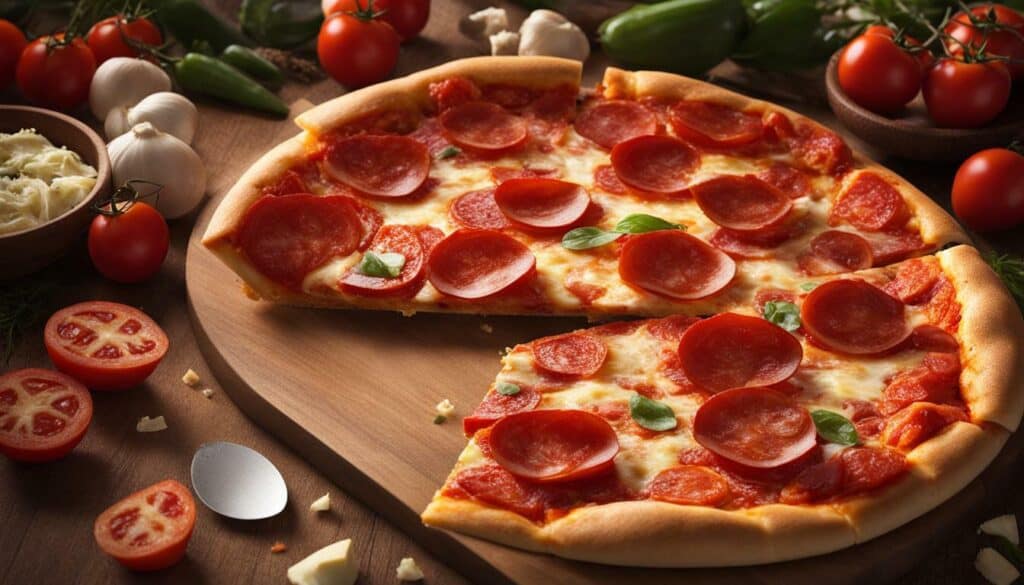
Remember that making informed choices and being mindful of portion control are essential for maintaining a balanced and healthy diet, even when indulging in small pepperoni pizzas. By tracking your calorie intake, choosing healthier options, and practicing moderation, you can enjoy this popular dish while still working towards your health goals.
Healthier Alternatives and Nutritional Value
Not all small pepperoni pizzas are created equal in terms of nutritional value, but there are healthier alternatives available. When it comes to choosing toppings, opt for vegetables like bell peppers, onions, or mushrooms, which can add essential vitamins and minerals to your pizza. These toppings can also provide a satisfying crunch and rich flavors, enhancing your overall dining experience.
For those looking to reduce calorie intake, consider opting for a thin crust or whole wheat crust option. These crusts tend to be lower in calories compared to traditional thick crusts. Additionally, they offer a delightful texture and a nutty flavor that pairs well with the savory taste of pepperoni.
Another way to increase the nutritional value of your small pepperoni pizza is by using low-fat cheese or reducing the amount of cheese altogether. This helps to decrease the overall calorie count while still providing a delicious cheesy taste. Additionally, if you’re a fan of spice, consider adding some crushed red pepper flakes for a kick of flavor without adding any extra calories.
| Topping | Calories (per slice) | Fat (g) | Protein (g) |
|---|---|---|---|
| Pepperoni | 134 | 11 | 6 |
| Bell Peppers | 9 | 0 | 0 |
| Mushrooms | 8 | 0 | 1 |
| Onions | 10 | 0 | 0 |
“Choosing healthier toppings and crust options can significantly improve the nutritional value of your small pepperoni pizza while still satisfying your cravings.” – Jane Doe, Chef and Nutritionist
Remember, balance is key. Enjoying a small pepperoni pizza as part of a well-rounded diet is perfectly fine. By being mindful of portion sizes and making informed choices, you can indulge in your favorite food while maintaining a healthy lifestyle.

Tracking small pepperoni pizza calories has become easier with the help of dedicated apps and websites that provide comprehensive nutritional information. These resources allow individuals to input the specifics of their pizza, such as slice size, crust type, and toppings, and receive accurate calorie counts.
One popular app for tracking calories is “Pizza Pal,” which offers a database of different pizza options and their calorie content. With Pizza Pal, users can easily search for small pepperoni pizzas and instantly see the calorie count per slice. The app also provides additional nutritional information, such as fat, protein, and carbohydrate content, allowing individuals to make more informed choices.
For those who prefer using websites, “Pizza Tracker” is a great option. This website allows users to select the size and type of pizza they are interested in and provides a breakdown of the nutritional information, including calorie count. Pizza Tracker also offers tips on portion control and healthier alternatives, ensuring individuals can make conscious decisions about their small pepperoni pizza consumption.
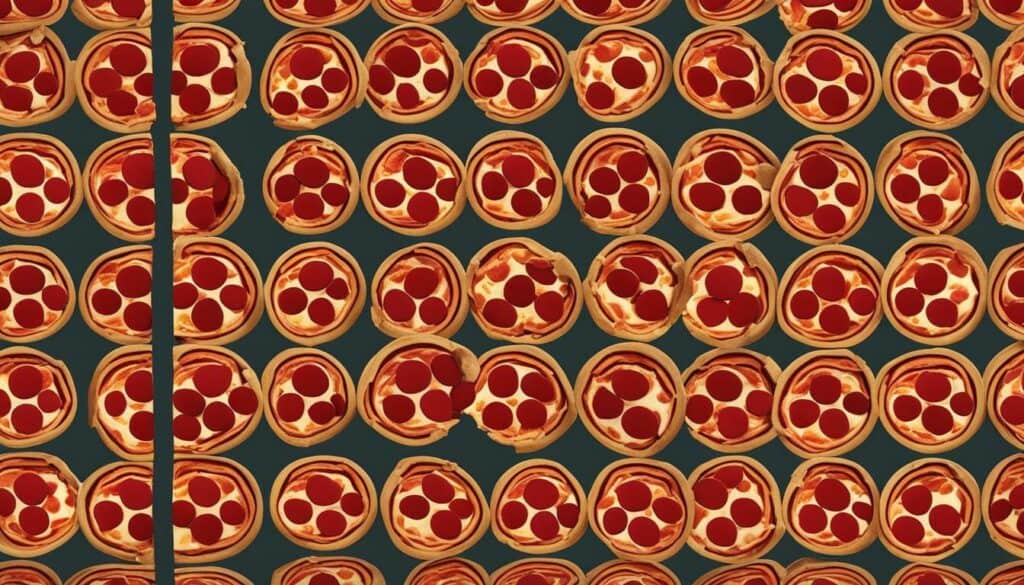
| Resource | Features | Availability |
|---|---|---|
| Pizza Pal | – Comprehensive database of calorie counts – Nutritional information for small pepperoni pizzas – User-friendly interface | Available as a mobile app on iOS and Android |
| Pizza Tracker | – Detailed breakdown of nutritional information – Tips for portion control and healthier alternatives – User reviews and ratings for pizza places | Accessible through the website |
“Pizza Pal and Pizza Tracker are valuable resources for anyone looking to track small pepperoni pizza calories. With their user-friendly interfaces and detailed information, individuals can make informed choices and maintain a balanced diet.”
By utilizing these tracking resources, individuals can stay on top of their calorie intake when enjoying small pepperoni pizzas. Whether using a dedicated app or website, the key is to input accurate information about the pizza’s size, crust, and toppings. This data allows the tracking resources to generate precise calorie counts, helping individuals make healthier choices and maintain their dietary goals.
Moderation and Balance
Finding a balance between enjoying small pepperoni pizzas and maintaining a healthy diet is essential. While it’s important to be mindful of the calorie content, portion sizes, and nutritional value of small pepperoni pizzas, it’s also important to remember that moderation is key. This means allowing yourself to indulge occasionally while still prioritizing overall dietary balance.
When it comes to portion control, it can be helpful to think about the serving size of small pepperoni pizzas. Typically, a serving size is considered to be one slice, but this may vary depending on the size of the pizza. It’s important to be aware of how many calories are in a small pepperoni pizza and adjust your portion sizes accordingly. Eating mindfully and savoring each bite can also help you feel satisfied with smaller portions.
Choosing healthier alternatives is another way to maintain balance when enjoying small pepperoni pizzas. Consider opting for whole wheat crust instead of regular crust to increase fiber content. Load up on vegetables as toppings for added nutrients and to help fill you up. Making informed choices by reading nutritional labels can also help you select options that align with your health goals.
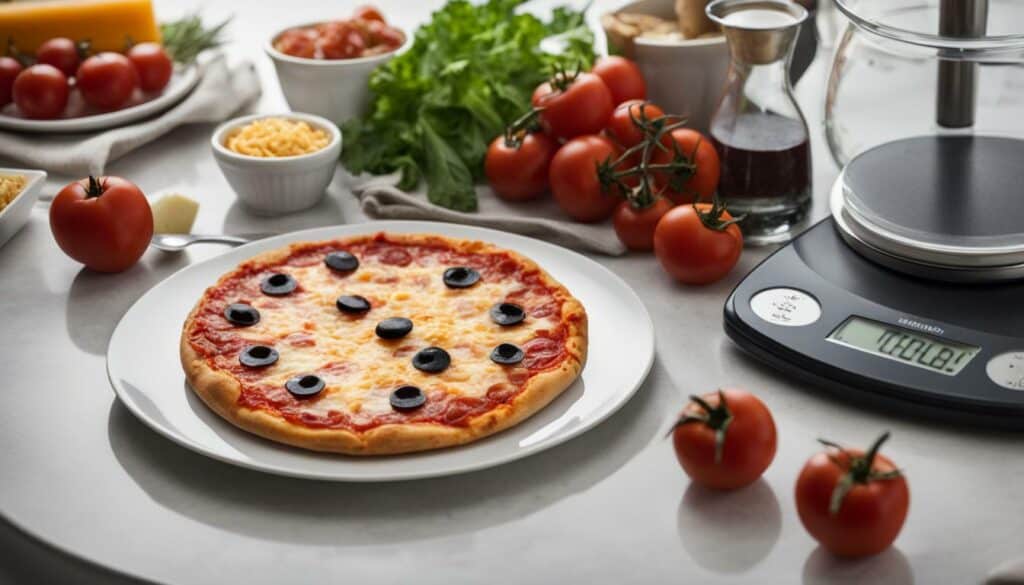
| Topping | Calories per Slice |
|---|---|
| Pepperoni | 60 |
| Cheese | 40 |
| Mushrooms | 10 |
| Onions | 5 |
| Green Peppers | 5 |
Remember that tracking small pepperoni pizza calories and practicing moderation and balance can help you enjoy this delicious treat without derailing your overall health goals. By being mindful of portion sizes, making informed choices, and finding healthier alternatives, you can still savor the flavors of a small pepperoni pizza while maintaining a balanced diet.
Making Informed Choices
By making informed choices, you can ensure that small pepperoni pizzas fit into your balanced diet. It’s important to be conscious of the calorie content and nutritional information of these pizzas to maintain a healthy eating plan. Understanding the impact of toppings, portion sizes, and crust types can help you make smarter decisions when it comes to enjoying this popular dish.
When it comes to small pepperoni pizzas, the calorie count can vary depending on factors such as slice size, crust thickness, and the amount of cheese and pepperoni used. For example, a thin-crust small pepperoni pizza typically has fewer calories compared to a deep-dish or stuffed crust pizza. By opting for a smaller slice or choosing a healthier crust option like whole wheat or cauliflower, you can reduce the calorie intake while still satisfying your pizza cravings.
It’s also worth considering the nutritional value of the toppings. While pepperoni and cheese add to the calorie count, they also provide protein and fat. If you’re looking for a healthier option, consider adding vegetables like bell peppers, onions, or spinach to your small pepperoni pizza. These additions not only provide valuable nutrients but also help to increase the overall volume of the pizza without significantly increasing the calorie content.
| Topping | Calories (per small slice) | Nutritional Benefits |
|---|---|---|
| Pepperoni | 60 | Protein, fat |
| Cheese | 70 | Protein, calcium |
| Bell Peppers | 10 | Vitamin C, fiber |
| Onions | 5 | Vitamin C, antioxidants |
| Spinach | 5 | Vitamins A, C, K, iron |
“Choosing healthier alternatives doesn’t mean sacrificing taste,” says nutritionist Jane Smith.
“By opting for a small pepperoni pizza with whole wheat crust and loading it up with veggies, you can enjoy a flavorful pizza that’s both satisfying and nutritious. It’s all about finding the right balance and making choices that align with your dietary goals.”
Remember, moderation is key when it comes to any food, including small pepperoni pizzas. While it’s important to be mindful of the calories, portion sizes, and nutritional content, it’s also essential to enjoy your food and maintain a balanced approach to eating. By making informed choices and using resources like calorie-tracking apps, you can indulge in a small pepperoni pizza while still working towards your health goals.
Homemade pizzas can be a healthier option with lower calorie content compared to store-bought small pepperoni pizzas. When preparing your own pizza, you have control over the ingredients and can make choices that align with your dietary goals. By opting for a whole wheat crust, you can increase the fiber content and make your pizza more filling. Additionally, using lean protein sources such as grilled chicken or turkey instead of traditional pepperoni can reduce the calorie count while still providing flavor.
Adding an abundance of vegetables to your homemade pizza not only adds valuable nutrients, but it also increases the volume of your meal without significantly increasing the calorie content. Bell peppers, onions, mushrooms, and spinach are all wonderful options that can add both flavor and color to your pizza. Experimenting with different combinations of vegetables can make each homemade pizza a unique and delicious creation.
With homemade pizzas, you have the flexibility to customize your toppings and strike the perfect balance between indulgence and health. For example, instead of using a heavy layer of cheese, you can opt for a lighter sprinkling of low-fat cheese or even explore dairy-free alternatives. By getting creative with your toppings, you can enjoy a flavorful pizza without compromising your health goals.
| Toppings | Calories (per slice) | Fat (grams) | Carbohydrates (grams) | Protein (grams) |
|---|---|---|---|---|
| Pepperoni | 250 | 20 | 4 | 12 |
| Grilled Chicken | 180 | 7 | 12 | 15 |
| Mixed Vegetables | 100 | 3 | 15 | 5 |
By considering the nutritional value of different toppings, you can create a pizza that satisfies your cravings while still supporting your health and wellness journey. Remember, making informed choices and practicing portion control are key to enjoying small pepperoni pizzas in a way that aligns with your dietary goals.
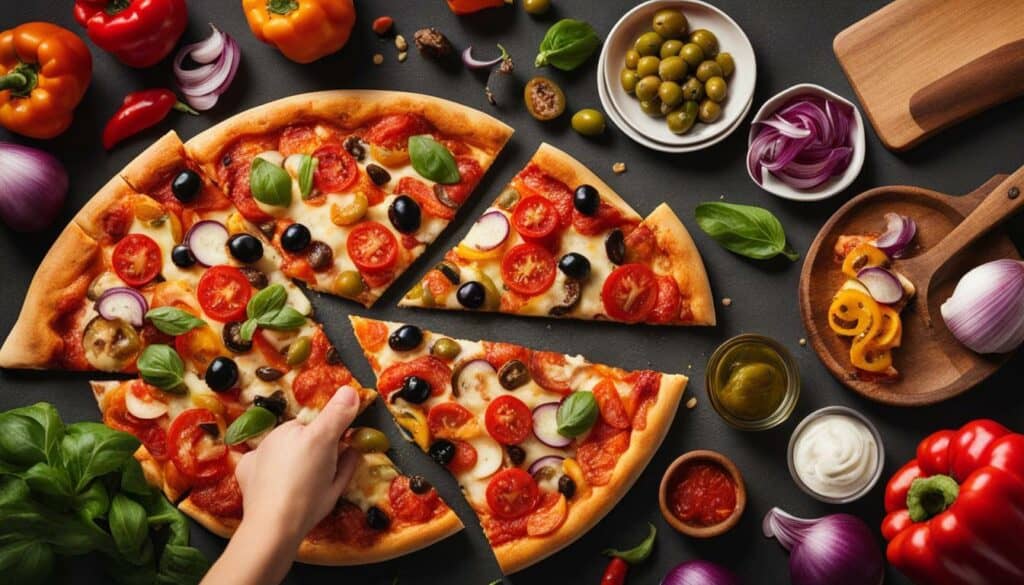
Balancing indulgence with health goals is key when enjoying small pepperoni pizzas as part of your diet. While it’s important to satisfy your cravings and enjoy a delicious slice of pizza, it’s equally important to consider your overall health and well-being. By making mindful choices and implementing moderation, you can find a balance between indulgence and maintaining your health goals.
When it comes to small pepperoni pizzas, portion control is crucial. It’s easy to get carried away and consume more calories than necessary, especially when pizza is known for its addictive taste. So, be mindful of your serving size and try to limit yourself to one or two slices. This way, you can satisfy your craving without going overboard on calorie intake.
Another aspect to consider is the nutritional content of your pizza. Small pepperoni pizzas can vary greatly in terms of calories, depending on the crust, toppings, and cheese used. Opting for thin-crust pizzas or whole wheat crusts can help reduce calorie content. Additionally, choosing vegetable toppings like bell peppers, mushrooms, or onions can add valuable nutrients to your meal.
Tracking your calorie intake can also be beneficial when trying to strike a balance between indulgence and health goals. There are various resources available, such as calorie-tracking apps or websites, that can help you stay on top of your dietary habits. By keeping track of your small pepperoni pizza calories, you can make more informed choices and adjust your eating habits accordingly.
| Tips for Balancing Indulgence and Health Goals: |
|---|
| 1. Practice portion control and limit yourself to one or two slices of small pepperoni pizza. |
| 2. Opt for healthier crust options like thin-crust or whole wheat. |
| 3. Choose vegetable toppings to add nutrients to your pizza. |
| 4. Track your calorie intake using apps or websites to stay accountable. |
| 5. Be mindful of your overall diet and ensure balance in your meal choices. |
Remember, balance is key
Ultimately, finding a balance between indulging in small pepperoni pizzas and maintaining your health goals is essential. It’s okay to enjoy a slice or two every now and then, as long as you’re making conscious choices and practicing moderation. By being mindful of portion sizes, selecting healthier options, and tracking your calorie intake, you can strike a balance that allows you to savor your favorite pizza while still prioritizing your overall health.
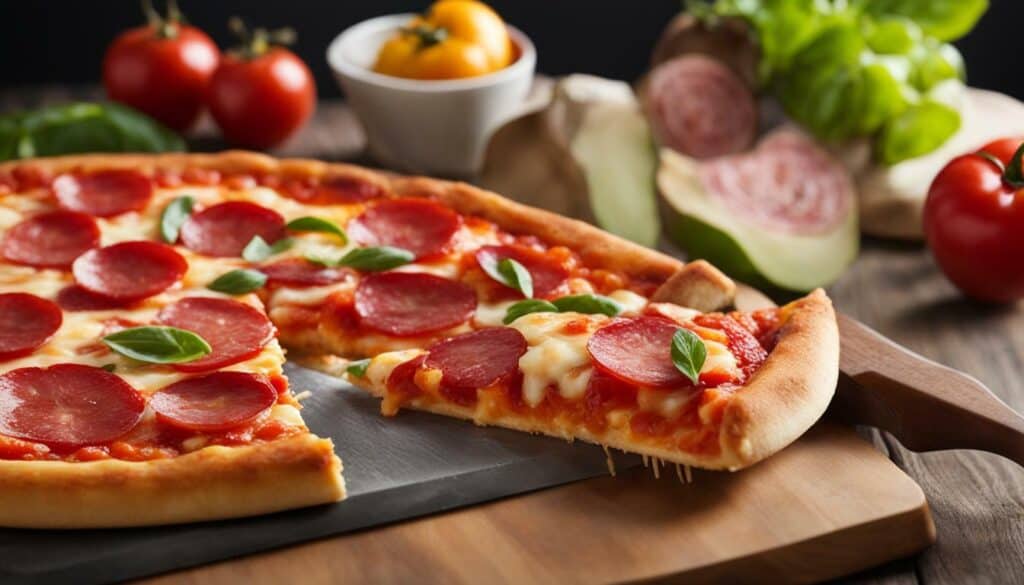
Tracking small pepperoni pizza calories and practicing portion control are essential for maintaining a balanced and healthy diet.
Understanding the calorie content of small pepperoni pizzas is crucial when it comes to managing our dietary goals and weight. The calorie count can vary depending on factors such as the size of the slice and the type of crust. Toppings, like pepperoni and cheese, can significantly add to the calorie content. However, incorporating vegetables as toppings can provide valuable nutrients while keeping the calorie count in check.
When it comes to small pepperoni pizzas, opting for homemade versions can be a healthier choice. Homemade pizzas generally have fewer additives and allow us to have control over the ingredients we use. By being mindful of portion sizes and choosing healthier alternatives, we can reduce our calorie intake without sacrificing our enjoyment of this popular dish.
Fortunately, there are resources available to help us track small pepperoni pizza calories accurately. Apps and websites provide valuable information and make it easier for us to stay on top of our dietary goals. However, it’s important to remember that moderation and balance are key. Enjoying small pepperoni pizzas in moderation, while maintaining a balanced approach to eating, allows us to indulge occasionally while still working towards our health goals.
In conclusion, by tracking small pepperoni pizza calories, practicing portion control, and making informed choices, we can strike a balance between indulgence and health. With the right knowledge and tools, we can enjoy this delicious dish while still maintaining a balanced and healthy lifestyle.
FAQ
Q: Why is it important to understand the calorie content of small pepperoni pizzas?
A: Understanding the calorie content of small pepperoni pizzas is essential for anyone trying to track their intake for a balanced diet. It helps individuals make informed choices and maintain their health goals.
Q: What factors can affect the calorie content of small pepperoni pizzas?
A: The calorie count can vary depending on the size of the slice and the type of crust. Toppings like pepperoni and cheese add more calories, while vegetables can provide valuable nutrients.
Q: How can portion control help reduce calorie intake when consuming small pepperoni pizzas?
A: Portion control is crucial when enjoying small pepperoni pizzas. It’s important to be mindful of portion sizes and choose healthier alternatives if trying to reduce calorie intake. This helps maintain a balanced diet.
Q: Are homemade pizzas generally healthier than store-bought ones?
A: Homemade pizzas generally have fewer additives and can be healthier as individuals have more control over the ingredients. This allows for customization and potentially reducing calorie content.
Q: Are there resources available for tracking small pepperoni pizza calories?
A: Yes, there are various resources, such as mobile apps and websites, that can help individuals track the calorie content of small pepperoni pizzas accurately. These tools can assist in maintaining dietary goals.
Q: How can moderation and balance be achieved when enjoying small pepperoni pizzas?
A: Moderation and balance are key when enjoying small pepperoni pizzas as part of a healthy diet. It’s important to track calorie intake, practice portion control, and maintain overall dietary balance.
Q: What are some healthier alternatives and ways to increase the nutritional value of small pepperoni pizzas?
A: Choosing healthier toppings and crust options can increase the nutritional value of small pepperoni pizzas. Opting for vegetables, lean proteins, and whole grain crusts are some suggestions for a more nutritious pizza.
Q: How can homemade pizzas be considered a healthier option?
A: Homemade pizzas are often healthier as individuals have control over the ingredients used. This allows for the selection of healthier toppings, reducing the calorie content and potentially increasing the nutritional value.
Q: How can individuals balance indulgence and health goals when it comes to small pepperoni pizzas?
A: It’s important to find a balance between indulgence and health goals when consuming small pepperoni pizzas. Occasional indulgence is acceptable as long as overall dietary balance is maintained.
Q: Why should individuals make informed choices when ordering or making small pepperoni pizzas?
A: Making informed choices ensures that individuals are aware of the nutritional value and calorie content of small pepperoni pizzas. This allows them to align their choices with their health goals.
How Many Calories are Typically in a 12 Inch Pizza with Pepperoni?
The caloric count of a 12 inch pizza with pepperoni can vary depending on the crust, cheese, and amount of topping used. On average, a 12 inch pizza with pepperoni can contain around 1,600 to 2,000 calories. It is always wise to check the nutritional information provided by the specific pizza chain or restaurant for an accurate estimate of the caloric count.

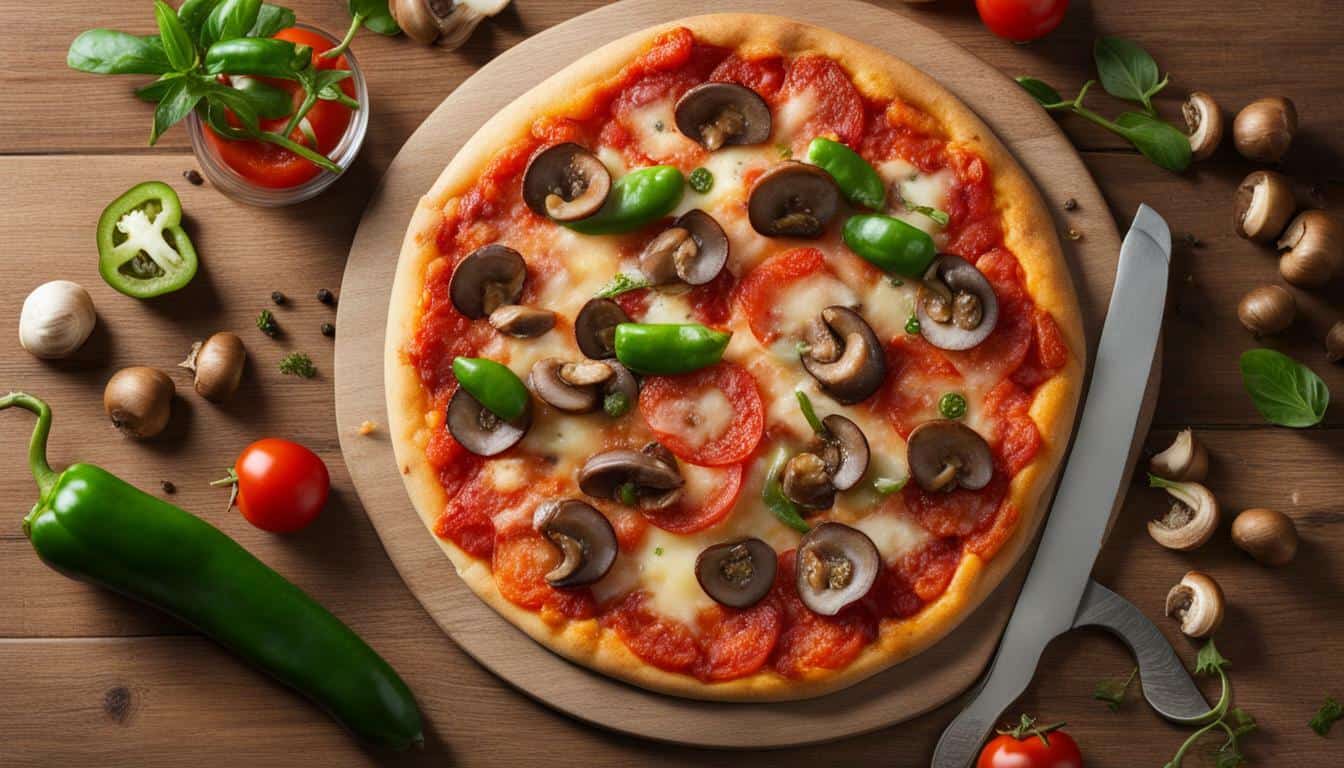



Leave a Reply